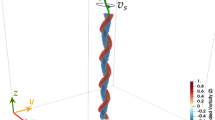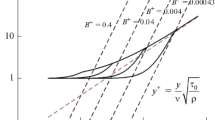Abstract
Noise may be used as a probe of the dynamics of a nonlinear system. Weak noise provides information on the local dynamics near a transition. This information can be helpful for identifying the underlying bifurcation. The normal form of the bifurcation can then be used as a starting point for a phenomenological model of the system. Such an approach furnishes a unified explanation of the experimental data near the transition between superfluid turbulent states TI and TII in liquid helium counterflow. Strong external noise probes global features of the nonlinearities of a system. It may also dramatically affect the dynamical behavior of the system and give rise to noise-induced transitions. The problems of modeling this phenomenon in the liquid helium counterflow system are discussed and a first model, providing a unified description of the experimental observations for weak and strong noise, is developed.
Similar content being viewed by others
References
M. Golubitsky and D. G. Schaeffer,Singularities and Groups in Bifurcation Theory (Springer, New York, 1985).
J. Guckenheimer and P. Holmes,Nonlinear Oscillations, Dynamical Systems, and Bifurcations of Vector Fields (Springer, New York, 1983).
K. Wiesenfeld,J. Stat. Phys. 38:1071 (1985);Phys. Rev. A 32:1744 (1985).
M. F. Schumaker and W. Horsthemke,Phys. Rev. A 36:354 (1987).
C. P. Lorenson, D. Griswold, V. U. Nayak, and J. T. Tough,Phys. Rev. Lett. 55:1494 (1985).
D. Griswold, C. P. Lorenson, and J. T. Tough,Phys. Rev. B 35:3149 (1987).
D. Griswold and J. T. Tough,Phys. Rev. A 36:1360 (1987).
W. Horsthemke and M. Malek Mansour,Z. Phys. B 24:307 (1976).
W. Horsthemke and R. Lefever,Phys. Lett. A 64:19 (1977).
L. Arnold, W. Horsthemke, and R. Lefever,Z. Phys. B 29:367 (1978).
A. Schenzle and H. Brand,Phys. Rev. A 20:1628 (1979).
W. Horsthemke and R. Lefever,Noise-Induced Transitions (Springer, Berlin, 1984).
W. Horsthemke and R. Lefever,Biophys. J. 35:415 (1981).
K. W. Schwarz,Phys. Rev. B 18:245 (1978);Phys. Rev. Lett. 49:283 (1982).
W. F. Vinen, inProgress in Low Temperature Physics, Vol.3, C. J. Gorter, ed. (North-Holland, Amsterdam, 1961), p. 1.
R. K. Childers and J. T. Tough,Phys. Rev. B 13:1040 (1976).
M. F. Schumaker, Ph.D. Dissertation, University of Texas, Austin (1987); M. F. Schumaker and W. Horsthemke, in preparation.
D. L. Griswold, Ph.D. Dissertation, Ohio State University, Columbus (1986).
Author information
Authors and Affiliations
Rights and permissions
About this article
Cite this article
Horsthemke, W., Schumaker, M.F. Noise and superfluid turbulence in He II: Theory. J Stat Phys 54, 1175–1188 (1989). https://doi.org/10.1007/BF01044710
Received:
Revised:
Issue Date:
DOI: https://doi.org/10.1007/BF01044710




